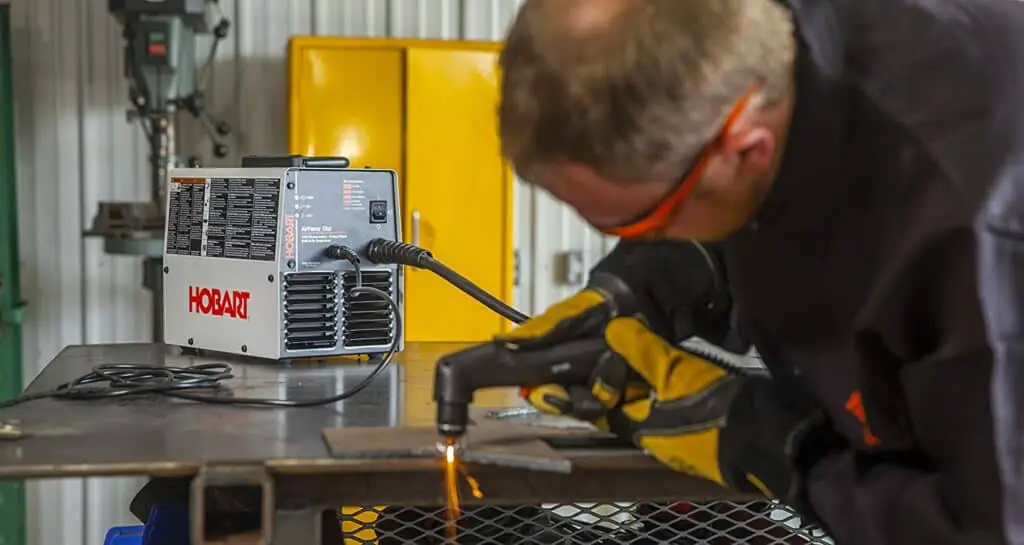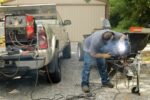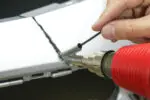These popular tools are ideal for metal cutting necessities you may have and in particular for automotive projects. They cut rapidly, saving you time and with great precision when working with metals.
We had our team of professional welders test dozens of plasma cutters to provide you with as much information as possible.
When selecting our best plasma cutters, we couldn’t help but like the Hobart Airforce 500564 12ci Plasma Cutter for the overall value that it brings to the table including a built-in air compressor.
However, if you happen to be on a limited budget, fear not because the Lotos LTP5000D 50 Amp Plasma cutter is a great budget buy and will offer you a pilot arc in the package.
| Brand | Ideal Cut | Severance cut | Max Amp | Duty Cycle | Voltage | Air Compressor | Weight (lbs) |
|---|---|---|---|---|---|---|---|
| Hobart Airforce 12ci | 1/8 inch | 1/4 inch | 12A | 35%@12A | 110V | Yes | 25.1 |
| Lotos LTP5000D | ½ inch | ¾ inch | 50A | 60%@50A | 110/220 | No | 26 |
| Hypertherm Powermax 30 AIR | 3/8 inch | 5/8 inch | 30A | 35%@30A | 110/220 | Yes | 29.8 |
| Hobart Airforce 40ci | 5/8 inch | 7/8 inch | 40A | 60%@40A | 120/240V | No | 21 |
The Reviews
Best Value Plasma Cutter
1.) Hobart Airforce 500564 12ci Plasma Cutter with Air Compressor
- Cuts faster than oxy fuel
- Smaller heat-affected zone for less warping
- No gas pressure settings for flame tuning needed
- More precise cut, thinner kerf, less slag to clean up
Prices pulled from the Amazon Product Advertising API on:
Product prices and availability are accurate as of the date/time indicated and are subject to change. Any price and availability information displayed on [relevant Amazon Site(s), as applicable] at the time of purchase will apply to the purchase of this product.
While this is not a powerful plasma cutter, it is a great quality-built unit especially for DIY projects that don’t require much power.
If you want a quality plasma cutter, this Hobart Airforce model even comes with a built-in air compressor so you can use it anywhere at any time.
It will afford you great results on thinner metals but will cut rather slowly on any metal more than 1/8-inch thick. Slag will build up. It runs on 110V.
If you need to cut thicker metals you would probably be better off with a 27ci or 40ci depending on your needs.
Pros
-
-
- Great for cutting thinner metals
- Features a built-in air compressor
- Dependable
- Portable
-
Cons
-
-
- Not powerful
- Not the best cutting over 1/8-inch metals
-
Best Budget-Buy Plasma Cutter
2.) Lotos Pilot Arc 50A non-touch Plasma Cutter LTP500D
- 50 Amp Digital Inverter Air Plasma Cutter
- Automatic Dual Voltage / Dual Frequency (110/220V 50/60Hz)
- PAPST Advanced German Cooling System
- Max Severance Thickness: 3/4
- Max Cut Thickness: 1/2
Prices pulled from the Amazon Product Advertising API on:
Product prices and availability are accurate as of the date/time indicated and are subject to change. Any price and availability information displayed on [relevant Amazon Site(s), as applicable] at the time of purchase will apply to the purchase of this product.
This is an extremely popular plasma cutter because it is a versatile cutter with an affordable price tag. Thanks to a quality pilot arc you can cut through rusty or painted metal with ease, and you can do so non-touch, so your hands are not at risk for touching the metal.
Despite its price it comes with dual voltage, however, it will need a 110V pigtail adapter should you want to use 110V.
Consumables have a short life span, but they are likewise on the lower end of the pricing range. This cutter can cut evenly and cleanly through half-inch steel.
You will need a bit more time when cutting half-inch and quarter-inch metal, however, 1/8-inch cutting is rapid. The cut width is a bit thick, so it is not your best choice for precision cutting.
This is good reliable choice if you have a limited budget. If you need something less expensive, look at Lotos’ LT5000D which is similar but comes without a pilot arc.
Pros
-
-
- Pilot arc
- Dual voltage
- Budget-friendly
- Cuts one-half inch cleanly
- Portable
-
Cons
-
-
- Not great for precise cutting needs
- Uses up consumables quickly
- Warranty only one year
-
Best Plasma Cutter featuring a Built-in Air Compressor
3.) Hypertherm Powermax 30 Air Hand 088096 System
- Operate it anywhere with the internal air compressor
- Plug into any 120 or 240 V power with Auto-Voltage technology and included plug adapters
- Highly portable. The smallest, lightest weight system in its class
- New AIR T30 torch is rugged and designed to withstand the toughest environments
- Do more in less time. Fast cutting speeds and superior cut quality result in less secondary operations
Prices pulled from the Amazon Product Advertising API on:
Product prices and availability are accurate as of the date/time indicated and are subject to change. Any price and availability information displayed on [relevant Amazon Site(s), as applicable] at the time of purchase will apply to the purchase of this product.
This is an American manufactured quality plasma cutter from Hypertherm, and it comes with a built-in air compressor making it exceptionally versatile.
This manufacturer only produces plasma cutters, so all their efforts, research, and technology are devoted to excellence in plasma cutters.
It is able to cut one-half-inch metal with relative ease, while 3/8-inch is the ideal cut for this machine. This brand also produces some of the very best consumables available on the market with a long life span.
At 29.8 pounds it is light enough to be easily transported. While somewhat expensive, it is a sound investment.
Pros
-
-
- Air compressor is built-in
- Lightweight and Portable
- Operates with Dual voltage 110/220V
- Made in the USA
- Consumables have a long-life span
- 3-year warranty
-
Cons
-
-
- Expensive
-
Best Power Plasma Cutter
4.) Hobart 40i Airforce Plasma Cutter #500576
- Dual-voltage capability with MVP (multi-voltage plug)
- XT40R torch
- Fan-on-demand
- Power factor correction (PFC) circuitry
- Postflow cooling circuit
Prices pulled from the Amazon Product Advertising API on:
Product prices and availability are accurate as of the date/time indicated and are subject to change. Any price and availability information displayed on [relevant Amazon Site(s), as applicable] at the time of purchase will apply to the purchase of this product.
This also is a quality plasma cutter from Hobart. It can cleanly cut 5/8-inch steel and can sever a whopping 7/8-inch metal meaning it brings tons of power to cut.
It also features dual voltage of either 120V or 240V and offers an impressive maximum power duty cycle of 60%@40Amps.
It is on the expensive side, although pretty much in line with the 27ci and 12ci Hobart Plasma Cutters. This cutter however packs a great deal more power.
It is great if you are working on industrial projects and is impressively lightweight at 21 pounds meaning portability is a breeze.
Pros
-
-
- Hobart Dependability
- Very powerful
- Operates on Dual voltage
- Lightweight portability at 21 lbs.
-
Cons
-
-
- Expensive
- Does not come with a built-in air compressor
-
What does a Plasma Cutter do?
This tool is a machine that will permit you to cut through stainless steel, brass, copper, aluminum, or any conductive metal.
Gas is pushed into a nozzle and when it emerges it joins with an electric arc that is generated by an electric power source.
Temperatures can reach as much as 40,000° Fahrenheit and be so intense will immediately cut and melt metals.
When Should a Plasma Cutter be Employed?
The Plasma Cutter tool is the ideal method for cutting metals. They cut very rapidly and offer more precision because the width of their cut is so small.
This signifies that the metal edges and immediate area will not be in any way affected by the intense heat. As this tool works with any conductive metal, it is exceptionally versatile.
A Plasma Cutter Buying Guide
There are quite a few things to consider when choosing your plasma cutter so here is our buyer’s guide to assist you in making your choice.
1.) Amperage. A plasma cutter’s amperage indicates how thick the metal can be when cutting. For example, a plasma cutter with 30A of power output should be able to cut 3/-inch metal sheets or pieces.
Also, by using a power source with 220Voltage, the amperage will be higher allowing you to cut thicker metals.
2.) Built-in Air Compressor. If the plasma cutter does not have a built-in air compressor you will most likely be required to have an air compressor so you can cut with it.
If your budget will allow you to invest a bit more, you can find a plasma cutter with an air compressor built-in. Prices will run higher, but you are paying for the convenience.
With a built-in compressor, you just plug your cutter into the socket and begin cutting your metal.
3.) Consumables. There are five parts to a plasma cutter that are considered to be consumables with varying life cycles. These parts include the swirl ring, shield cap, nozzle, retaining cap, and electrode.
Depending on what you are cutting, a bit of damage is inevitable if nothing else due to molten splatter. The nozzle’s hole, for instance, needs to be perfectly round or your cut will suffer. Higher-priced plasma cutters will feature longer-lasting consumables.
4.) Cost. This is a primary factor when acquiring a plasma cutter and can be decisive. Lower costing machines generally have a shorter life span.
An American-made welder will cost more than a cheap plasma cutter, but it will probably last three to five times longer. In the end, it comes down to you get a tool that equals your investment.
5.) Duty Cycle. The duty cycle refers to the amount of time that any plasma cutter will be able to continue cutting without having to stop for a cool down period.
An example would be a 60% duty cycle at a specific amperage which means that the cutter could run for six minutes out of every ten before needing to rest to avoid overheating.
If you will be making deep cuts into your preferred metal, a higher amperage with a longer duty cycle is recommended.
6.) Ideal Cut Capability. How thick of a piece, or sheet of metal, will a plasma cutter be able to cut is of primary importance. Know the average thickness of the metal that you will be regularly cutting or at least the most often.
Look for a plasma cutter with the capability to cut this metal at approximately ten inches per minute. This will provide you with the ideal cut capability that you need.
7.) Pilot Arc. The better, more advanced plasma cutters will feature a pilot arc as a cutting tool. This arc permits you to cut without the tip of the torch ever touching the metal. It is ideal for cutting metal that is rusty or painted or for mesh metal due to a continuous arc. Most quality tools will feature a pilot arc.
8.) Safety. This is your top priority when working with plasma cutters. Read any safety recommendations provided with your cutter by the manufacturer.
Safety glasses or goggles are absolutely necessary to protect your eyes from the welding arc, and leather gloves are essential for hand protection.
Synthetic gloves can melt during operation so they should be avoided. If not wearing a welding apron, legs, arms, and your body should be protected with a hardy cotton material to protect from sparks flying.
Also, protect your feet and toes with work boots that preferably have a steel or composite toe cap to avoid impact injuries from falling metal.
9.) Severance Thickness. A severance thickness signifies the maximum thickness of a piece of metal that a plasma cutter is able to cut. When doing severance thickness, the plasma cutter will cut very slowly, and the tool will not produce enough heat for a clean precise cut.
The cut will look rough and be filled with dross. When cutting regularly, the severance thickness is not recommended when you need great results.
10.) Voltage. If you will be using your plasma cutter at home for DIY projects, plasma cutters that use 110/115/120V power source inputs will work fine with a normal home indoor power outlet.
These are an especially good choice for beginners. Power, however, is limited. If you need more power from your cutter, you will require a 220V plasma cutter. Selecting a plasma cutter with both options for 110V or 220V is great for versatility.
11.) Weight. Weight is always a consideration when selecting power tools or small machinery. If you will be working in several places and portability is a consideration you will want a lightweight plasma cutter.
Because of inverter technology these cutters do weigh less, although, with an air compressor included, the weight will increase.
See also: Can I Use Plasma Cutter for Welding?
Conclusion
We hope our Plasma Cutter Buying Guide and Best Plasma Cutter List will assist you in finding the very best cutter for your budget and cutting needs. Thank you for reading.











